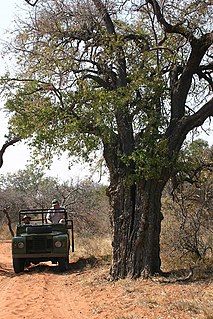
Spirostachys is a plant genus of the family Euphorbiaceae first described as a genus in 1850. It is native to Africa. Zuloaga, F. O., O. Morrone, M. J. Belgrano, C. Marticorena & E. Marchesi. (eds.) 2008. Catálogo de las plantas vasculares del Cono Sur. Monographs in systematic botany from the Missouri Botanical Garden 107(1–3): i–xcvi, 1–3348.

Galium divaricatum is a species of flowering plant in the coffee family known by the common name Lamarck's bedstraw.

Bahia ambrosioides is a South American species of flowering plants in the sunflower family. It is native to Chile including the Juan Fernández Islands.
Oplismenopsis is a genus of South American plants in the grass family. The only known species is Oplismenopsis najada, native to southern Brazil, Uruguay, and northeastern Argentina.
Neobouteloua is a genus of Argentine and Chilean plants in the grass family.
Eriachaenium is a genus of South American flowering plants in the daisy family.
Dolichlasium is a genus of flowering plants in the daisy family.
Duseniella is a genus of Argentine flowering plants in the daisy family.
Gamochaetopsis is a genus of flowering plants in the daisy family.
Huarpea is a genus of flowering plants in the daisy family.
Paleaepappus is a genus of flowering plants in the aster tribe within the sunflower family.

Tillandsia guelzii is a species in the genus Tillandsia. It is endemic to Jujuy Province of northern Argentina.
Tweedia is a genus of flowering plants in the family Apocynaceae, first described as a genus in 1835. The genus is native to South America. An ornamental plant, Oxypetalum coeruleum, formerly included in this genus is commonly referred to as "tweedia".
- Tweedia andina(Phil.) G.H.Rua - Chile
- Tweedia aucaensisG.H. Rua - Argentina
- Tweedia australis(Malme) C. Ezcurra - Argentina
- Tweedia birostrata(Hook. & Arn.) Hook. & Arn. - Chile
- Tweedia brunonisHook. & Arn. - Argentina, Bolivia, Paraguay
- Tweedia echegarayi(Hieron.) Malme - Argentina
- Tweedia solanoides(Hook. & Arn.) Chittenden - Argentina, Brazil, Paraguay, Uruguay

Hippeastrum aulicum, the Lily of the Palace, is a bulbous perennial, in the family Amaryllidaceae, native to the Atlantic Forest and Cerrado ecoregions from Brazil to Paraguay, in South America.

Rhyssostelma is a species of plants in the family Apocynaceae first described as a genus in 1844. It contains only one known species, Rhyssostelma nigricans, endemic to Argentina.
Guynesomia is a genus of Chilean flowering plants in the aster tribe within the sunflower family.

Ribes magellanicum is a South American species of shrubs in the currant family, found in Patagonia.

Rubus geoides is a South American species of flowering plant in the rose family. It has been found only in the extreme southern part of the continent, in the Provinces of Tierra del Fuego, Santa Cruz, Río Negro, and Neuquén in Argentina, the adjacent Magallanes Region of Chile, and the Falkland Islands.

Philodendron appendiculatum, also known as güembé, is a perennial species in the genus Philodendron, belonging to the family Araceae. It lives in the jungles, wetlands, and moist forests of South America.

Allenrolfea is a genus of shrubs in the family Amaranthaceae. The genus was named for the English botanist Robert Allen Rolfe. There are three species, ranging from North America to South America.










